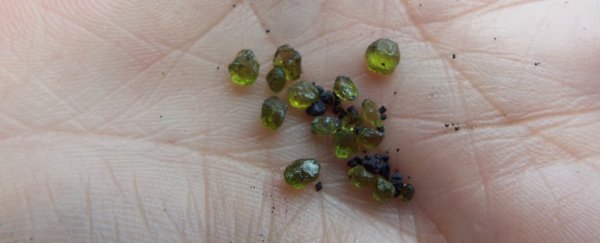Correction (26 June 2018): An earlier version of this story got a couple things wrong, for which we apologise. As Associated Press highlighted in a recent Fact Check, the pretty green pebbles we saw on social media are most likely olivine chunks from older lava flows, not the current eruption happening at Kīlauea.
While it's true that olivine can form thanks to volcanoes, the lava has to be crushed so that one can access the mineral; additionally, it takes time for it to weather into the shiny green things in the picture above, according to what geology professor Michael Garcia has told the AP.
And there's another technicality: while the gemstone form of olivine is indeed called peridot, the small chunks of the mineral found in Hawaii wouldn't really qualify, as they are not of gemstone quality. We have corrected these errors in the story below.
Original story (14 June 2018): If Hawaii's Kīlauea volcano were to offer an apology for its chaos and destruction, it just might come in the form of a beautiful green mineral called olivine.
Over the past months we've reported on devastating lava flows and bone-shattering boulders. Now people are finding olivine crystals on the ground, which is actually not as surprising as you'd first think.
Olivine is an incredibly common mineral - chemically speaking, it's magnesium iron silicate. Carried to the surface on volcanic hotspots, it often taints dark igneous rocks such as basalt with mossy green hues.
Finding it in the form of discrete lumps that jewellers would recognise as a gem called peridot is surprisingly rare - thanks in part to its tendency to weather into tiny sand-grains.
The olivine pebbles found by Hawaii residents are not gemstone quality, but they're still really pretty. Decent-sized crystals have been found amid rocks and a'a lava flows, although not necessarily the ones from the current eruption.
Some olivines that popped out of an a'a flow. Kilauea's little gems. #hawaii #kilauea #olivine #lovevolcanoes https://t.co/1X2ACcWu7n pic.twitter.com/8UaA1IrKEd
— GEOetc (@GEOetc2) June 10, 2018
Olivine can form when volcano eruptions spray magma high into the air, where the high crystallisation temperatures of magnesium iron silicates allow them to transform into bits of olivine, which are then encased in chunks of lava.
As lava weathers over time, the olivine gets exposed to the elements and weathers down further, which is how the Big Island's famous Papakōlea beach became known for its green sand.
Collecting these lovely green pebbles probably won't increase your bank balance a great deal. It's not exactly an expensive gem.
But they're certainly pretty - and at least it's something nice coming out of the destruction of Hawaii's formidable volcanoes.
